Repository
https://github.com/steemit/steem
Analysis Goals and Conditions
① Goals
First, for reference, we will simply calculate the theoretical expected curation yield.
And based on the data from January 1 to January 31 of this year, we will check actual curation yield distribution and its average yield.
We will compare the average number of votes and effective SP average for each major curation yield section to identify the characteristics and check the correlation coefficient.
Finally, I will summarize the overall implications through the data.
② Conditions
For the effectiveness, efficiency, and convenience of the calculations, we used only accounts that met all of the following criteria. The view time is February 8, 07:00 UTC.
- During that period, accounts with an effective SP of over 50
- Accounts with curation rewards received between January 1 and January 31 of this year
- Accounts that have been voted on between December 25th and January 24th of last year
- Accounts without power-up, power-down, delegation records from December 25 last year
For reference, from December 25 last year, the number of votes casted to the viewpoint is 17,585, and the effective SP sum is 77.7M. The number of accounts used in this analysis is 7,496, which is 43% of the total, and the sum of the effective SP is 20.3M, which is 26% of the total. This is enough data to confirm the recent actual curation yield distribution.
Analysis Table
- Theoretical expectation curation yield
- Actual curation yield distribution
① Curation yield distribution and average yield
② Characteristics and correlation of the major curation rate sections - Conclusion
Contents
1. Theoretical expectation curation yield
As you can see from the above table, the current STEEM inflation rate is 8.57%, so the theoretical expectation curlation rate is 1.61%.
- 1.61% = 8.57% * 75% * 25%
However, since many of the STEEMs are in liquidity, if one-third of the total STEEMs are liquid, the expected curation rate rises to 2.4%.
- 2.4% = 8.57% * 75% * 25% * (3/2)
For reference, because the curation reward is designed as a nonlinear compensation curve, the voting time, the amount of rewards in the post, and the voting order are the most important factors.
2. Actual curation yield distribution
① Curation yield distribution and average yield
We used the following formula to calculate the actual curation yield.
Curation rate (YoY, annual conversion) = (obtained curation SP / (Effective SP at time of inquiry - obtained curation SP)) * 365/31
In the table above, the average curation yield of 7,496 accounts satisfying all constraints is 2.2%. The average effective SP was 2,7K and the average number of votes was 435 (14 votes per day).
In the table above, the percentage of accounts with a curation yield lower than the average yield of 2.2% is 62%.
Looking at the yield distribution chart above, this means that curation yields can vary considerably depending on effort. It is a lot around the average, but it has a complete nonlinear curve shape.
The above distribution shows only accounts with less than 20% yield, including 99.8% of the total. A more realistic nonlinear curve can be seen clearly.
However, based on the bar graph above, 62% of all accounts are below average yield, 90% are below 5% yield, and 98% are below yield 10%.
Therefore, only accounts with less than 2% gain over 10% yield. This is a very rare case. Accounts with an excess yield of 20% are only 0.2%.
Therefore, it should be remembered that it is very difficult to record high returns in the current curation reward system.
② Characteristics and correlation of the major curation rate sections
Curation rewards are designed to be the most important factor in voting time, the amount of rewards and the order of votes, so other variables may be in fact secondary.
However, for each of the major curation yield sections, some features are visible.
Up to the yield of 15%, the higher the daily average number of votes, the higher the curation yield. This also appears weak in the distribution chart below.
Up to 10% yield, the higher the effective SP average, the higher the curation yield. However,
It is very faint in the distribution. And as the effective SP rises, it becomes very difficult to increase the curation yield.
Actually, the positive correlation between the curation yield and the daily average number of votes was 25%, and there was a positive correlation of only 6% with the effective SP average. Please refer to the table below.
3. Conclusion
The actual curation yield distribution was closely following the nonlinear compensation curve designed for motivation of the curation.
62% had less than average yield (= 2.2%). This is also related to the lack of consistency in voting.
28% is higher than the average yield, but yields less than 5%. If you continue to vote, you will be at least in this section.
8% achieved yields of over 5% and less than 10%. If you make an effort as a curator to quickly vote on popular articles, you might be part of this section.
Only 2% had a yield of over 10%, of which only 0.2% had yields above 20%. In order to be part of the top 2% of the yield criteria, there will be only a small chance when you vote almost as efficiently as a machine.
And there is a slight positive correlation (= 25%) between daily average number of votes and curation yield.
And as the effective SP rises, it becomes very difficult to increase the curation yield.
Additional implications are limited to some accounts that use automatic voting bots, among those that result in high curation yield.
In fact, the increased use of automated voting bots has the advantage of enabling broad voting, but it also has negative side effects that reduce pageviews and average number of comments.
Very few accounts that get the best yields are likely to vote hundreds of times a day, usually without reading the posts via the automated voting bots. It is not an issue because it does not have a lot of numbers and the effective SP is low, but it seems that there is a possibility to distort the reward pool by not reading the article and acquiring a high profit rate without paying attention to the curation effort.
Of course, most accounts that use automatic voting bots often write a list of favorite authors, vote a few or dozens of times a day, and then read the posts that are later voted on. Therefore, it is difficult to say that we did not make curation efforts in this case.
In this case, however, we need to worry about getting more revenue than an account that has been late reading and manually voting because we voted first with automatic voting bots.
It means that we need to do mid to long term research on the curation reward system in order to make a more active STEEM chain through a fair distribution rather than to ban the use of automatic voting bots right now.
In addition, curation is an essential part of the STEEM chain that places importance on the "value of content", and through active curation, you can also get various benefits yourself. Therefore, curation should not be viewed simply as a yield criterion.
Thanks for reading.
The Data and Queries
I did this analysis by connecting to the @steemsql db with MSSQL client(Microsoft SQL server management studio), Excel.
Refer to My Github
(My main analyzes)
Analysis of Voting Pattern: From posting to payout
SBD Debt Ratio Management Trend Analysis : Who removed our SBD?
(STEEM) All we need is time? Nope. More innovative action is needed.
The current (actual) inflation rate of STEEM is quite different from the design.
Proof-of-Brain or Power-of-Bid(bot), that is the question.
Analysis of SBD supply balance trend
The recent rise in STEEM prices may have been driven by Tanos' thumb.




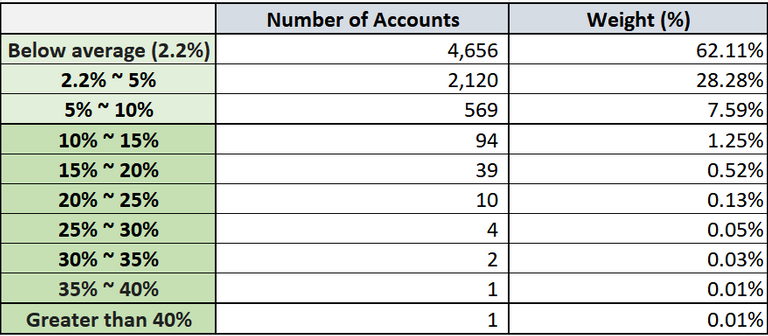
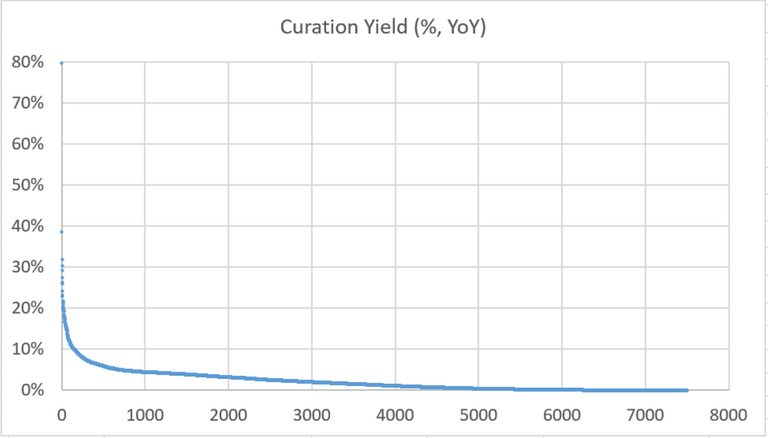
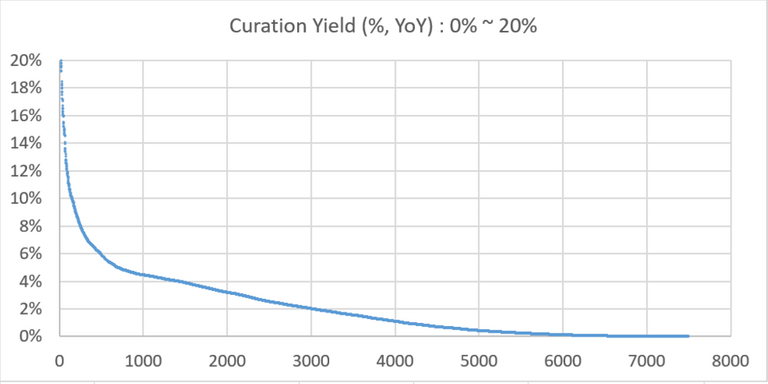
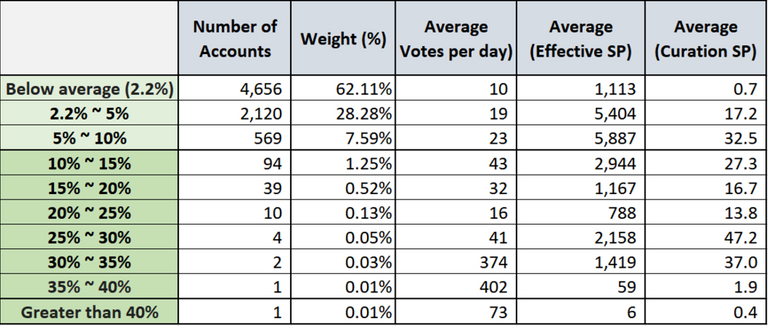
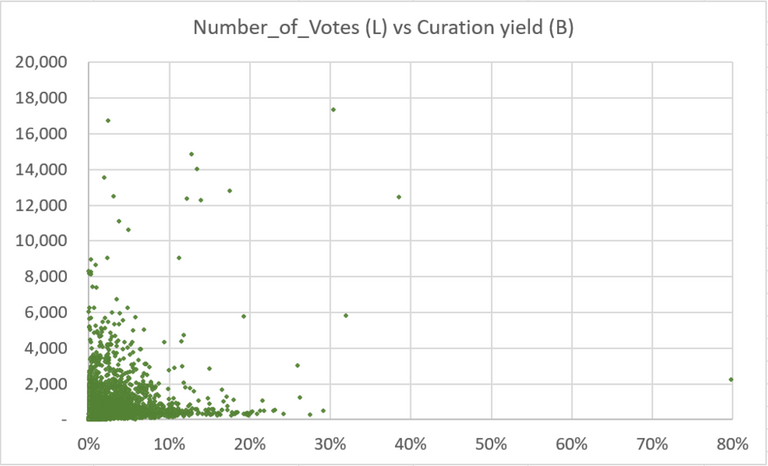
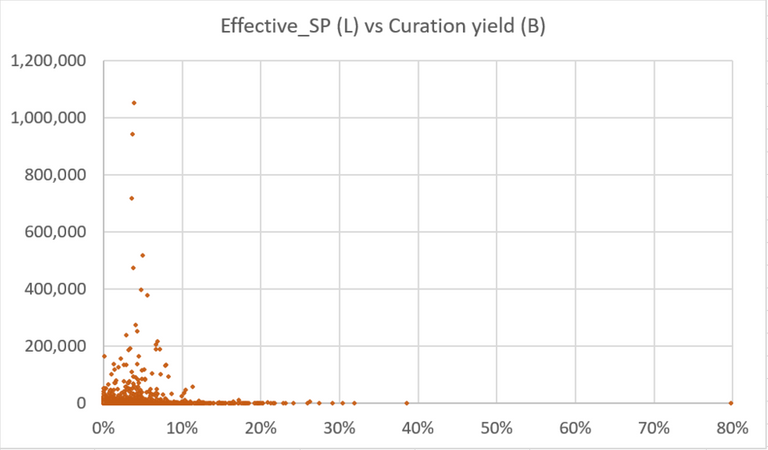

This post has been included in the latest edition of SoS Daily News - a digest of all you need to know about the State of Steem.
Thank you all the time. Have a great weekend.
This is really interesting and I appreciate the insight provided here. I have been so focused on content that I am sure I am not being efficient in my curation efforts. How can one review where we could improve? Thanks!
Posted using Partiko iOS
Active curators who focus on other people's content will probably benefit from their posts.
Therefore, it is not a good idea to simply increase curation yield. Of course, not all Steemians can focus on curation activities. For those accounts, it seems that they usually earn revenue through delegation.
Nevertheless, I think that as a curator, those who spend a lot of time in STEEM should benefit more.
For example, we can think of lowering the voting value of some automatic voting bots compared to manual voting.
짱짱맨 호출에 응답하여 보팅하였습니다.
Congratulations! Your post has been selected as a daily Steemit truffle! It is listed on rank 13 of all contributions awarded today. You can find the TOP DAILY TRUFFLE PICKS HERE.
I upvoted your contribution because to my mind your post is at least 10 SBD worth and should receive 233 votes. It's now up to the lovely Steemit community to make this come true.
I am
TrufflePig, an Artificial Intelligence Bot that helps minnows and content curators using Machine Learning. If you are curious how I select content, you can find an explanation here!Have a nice day and sincerely yours,

TrufflePigHi @lostmine27!
Your post was upvoted by @steem-ua, new Steem dApp, using UserAuthority for algorithmic post curation!
Your post is eligible for our upvote, thanks to our collaboration with @utopian-io!
Feel free to join our @steem-ua Discord server
Hey, @lostmine27!
Thanks for contributing on Utopian.
We’re already looking forward to your next contribution!
Get higher incentives and support Utopian.io!
Simply set @utopian.pay as a 5% (or higher) payout beneficiary on your contribution post (via SteemPlus or Steeditor).
Want to chat? Join us on Discord https://discord.gg/h52nFrV.
Vote for Utopian Witness!